Health Workforce Planning in Australia: Immigration and Policy Review
VerifiedAdded on 2023/01/13
|10
|2349
|21
Report
AI Summary
This report provides an in-depth analysis of Australia's health workforce, highlighting significant challenges such as an aging population, increased demand for healthcare services, and the changing burden of disease. It emphasizes the critical reliance on international health worker immigration to meet workforce supply, particularly in nursing, medicine, and midwifery. The report discusses current government policies, historic reasons for immigration, and the sustainability of these policies. It also examines the negative impacts of health worker migration and suggests strategies to mitigate them, including addressing the drivers of involuntary migration, improving assessment techniques, and creating public education programs. The report concludes by emphasizing the need for policy changes to ensure fair treatment of migrant workers and address shortages in allied health professions.
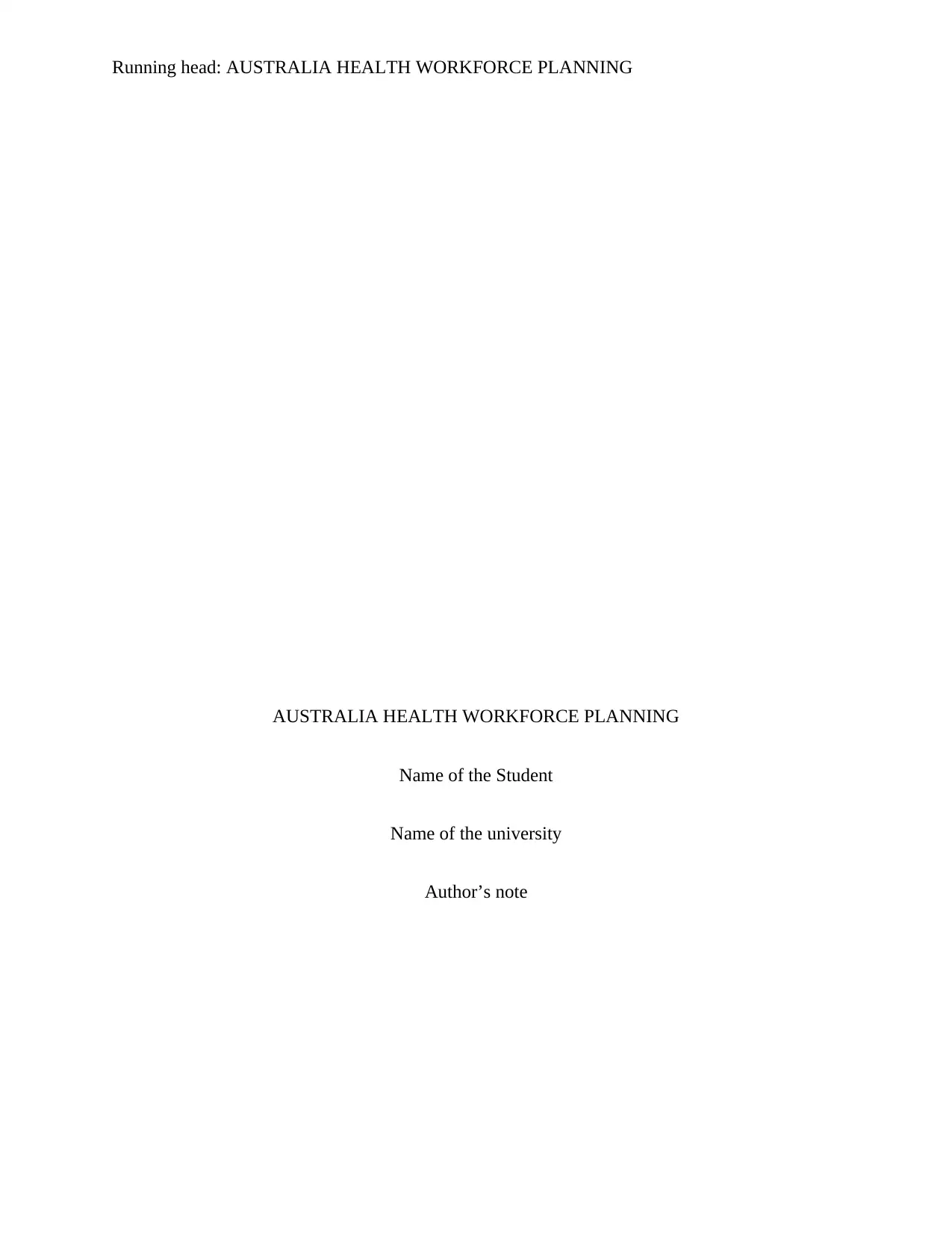
Running head: AUSTRALIA HEALTH WORKFORCE PLANNING
AUSTRALIA HEALTH WORKFORCE PLANNING
Name of the Student
Name of the university
Author’s note
AUSTRALIA HEALTH WORKFORCE PLANNING
Name of the Student
Name of the university
Author’s note
Paraphrase This Document
Need a fresh take? Get an instant paraphrase of this document with our AI Paraphraser

1AUSTRALIA HEALTH WORKFORCE PLANNING
Dependence of Australia on the international health worker immigration to meet the
workforce supply
The health workforce of Australia is facing significant challenges that includes ageing
population, increased emand for the health services, the changing burden of the disease, health
expenditure and broadened burden of the disease and large health expenditure World health
organization (2017).
There is an immediate need of the national workforce planning, due to the need to deal
wit significant increase in the number of medical students that has occurred over the last few
decades. A large number of doctors are going to retire in the year 2025. Hence, it is necessary to
replace the retiring doctors between 10-15 years (Commission on health employment and
economic growth, 2016).
Nurses plays a pivotal role in any properly functioning health care setting, but the nursing
shortage in Australia is a severe problem. It has been estimated that in 2016, the current supply
of efficient registered nurses had been about 241,380 , but there is a demand of about 254,541
nurses , showing a gap of about 17000 nurses. It can be estimated that by 2025, the demand gap
will increase upto 80,000 (Australian government, Department of health, 2018). The data is
similar for the doctors. As per the AIHW worforce and hours demand for the Australian
midwives will increase to 2030. For the nurses and the midwives the average age of the
workforce is about 44, with 39 % of the workforce aged more than 50 years (Australian
government, Department of health, 2018). The business hence continues to remain reliant on the
skilled migration of the nurses, midwives and the health care experts for providing a balanced
health care model. Without the immigration of the senior staffs to replace the retiring staffs, the
Dependence of Australia on the international health worker immigration to meet the
workforce supply
The health workforce of Australia is facing significant challenges that includes ageing
population, increased emand for the health services, the changing burden of the disease, health
expenditure and broadened burden of the disease and large health expenditure World health
organization (2017).
There is an immediate need of the national workforce planning, due to the need to deal
wit significant increase in the number of medical students that has occurred over the last few
decades. A large number of doctors are going to retire in the year 2025. Hence, it is necessary to
replace the retiring doctors between 10-15 years (Commission on health employment and
economic growth, 2016).
Nurses plays a pivotal role in any properly functioning health care setting, but the nursing
shortage in Australia is a severe problem. It has been estimated that in 2016, the current supply
of efficient registered nurses had been about 241,380 , but there is a demand of about 254,541
nurses , showing a gap of about 17000 nurses. It can be estimated that by 2025, the demand gap
will increase upto 80,000 (Australian government, Department of health, 2018). The data is
similar for the doctors. As per the AIHW worforce and hours demand for the Australian
midwives will increase to 2030. For the nurses and the midwives the average age of the
workforce is about 44, with 39 % of the workforce aged more than 50 years (Australian
government, Department of health, 2018). The business hence continues to remain reliant on the
skilled migration of the nurses, midwives and the health care experts for providing a balanced
health care model. Without the immigration of the senior staffs to replace the retiring staffs, the
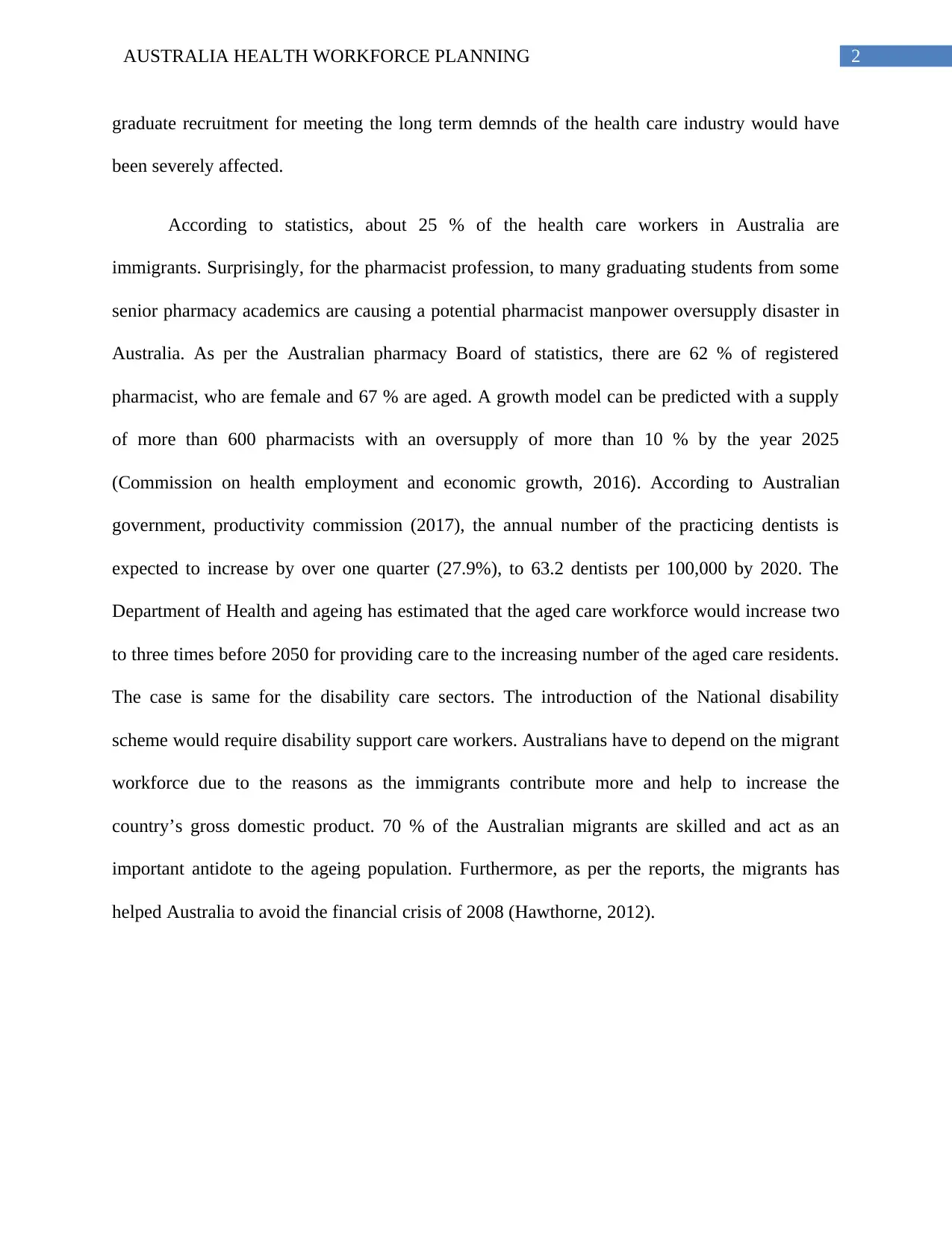
2AUSTRALIA HEALTH WORKFORCE PLANNING
graduate recruitment for meeting the long term demnds of the health care industry would have
been severely affected.
According to statistics, about 25 % of the health care workers in Australia are
immigrants. Surprisingly, for the pharmacist profession, to many graduating students from some
senior pharmacy academics are causing a potential pharmacist manpower oversupply disaster in
Australia. As per the Australian pharmacy Board of statistics, there are 62 % of registered
pharmacist, who are female and 67 % are aged. A growth model can be predicted with a supply
of more than 600 pharmacists with an oversupply of more than 10 % by the year 2025
(Commission on health employment and economic growth, 2016). According to Australian
government, productivity commission (2017), the annual number of the practicing dentists is
expected to increase by over one quarter (27.9%), to 63.2 dentists per 100,000 by 2020. The
Department of Health and ageing has estimated that the aged care workforce would increase two
to three times before 2050 for providing care to the increasing number of the aged care residents.
The case is same for the disability care sectors. The introduction of the National disability
scheme would require disability support care workers. Australians have to depend on the migrant
workforce due to the reasons as the immigrants contribute more and help to increase the
country’s gross domestic product. 70 % of the Australian migrants are skilled and act as an
important antidote to the ageing population. Furthermore, as per the reports, the migrants has
helped Australia to avoid the financial crisis of 2008 (Hawthorne, 2012).
graduate recruitment for meeting the long term demnds of the health care industry would have
been severely affected.
According to statistics, about 25 % of the health care workers in Australia are
immigrants. Surprisingly, for the pharmacist profession, to many graduating students from some
senior pharmacy academics are causing a potential pharmacist manpower oversupply disaster in
Australia. As per the Australian pharmacy Board of statistics, there are 62 % of registered
pharmacist, who are female and 67 % are aged. A growth model can be predicted with a supply
of more than 600 pharmacists with an oversupply of more than 10 % by the year 2025
(Commission on health employment and economic growth, 2016). According to Australian
government, productivity commission (2017), the annual number of the practicing dentists is
expected to increase by over one quarter (27.9%), to 63.2 dentists per 100,000 by 2020. The
Department of Health and ageing has estimated that the aged care workforce would increase two
to three times before 2050 for providing care to the increasing number of the aged care residents.
The case is same for the disability care sectors. The introduction of the National disability
scheme would require disability support care workers. Australians have to depend on the migrant
workforce due to the reasons as the immigrants contribute more and help to increase the
country’s gross domestic product. 70 % of the Australian migrants are skilled and act as an
important antidote to the ageing population. Furthermore, as per the reports, the migrants has
helped Australia to avoid the financial crisis of 2008 (Hawthorne, 2012).
⊘ This is a preview!⊘
Do you want full access?
Subscribe today to unlock all pages.

Trusted by 1+ million students worldwide
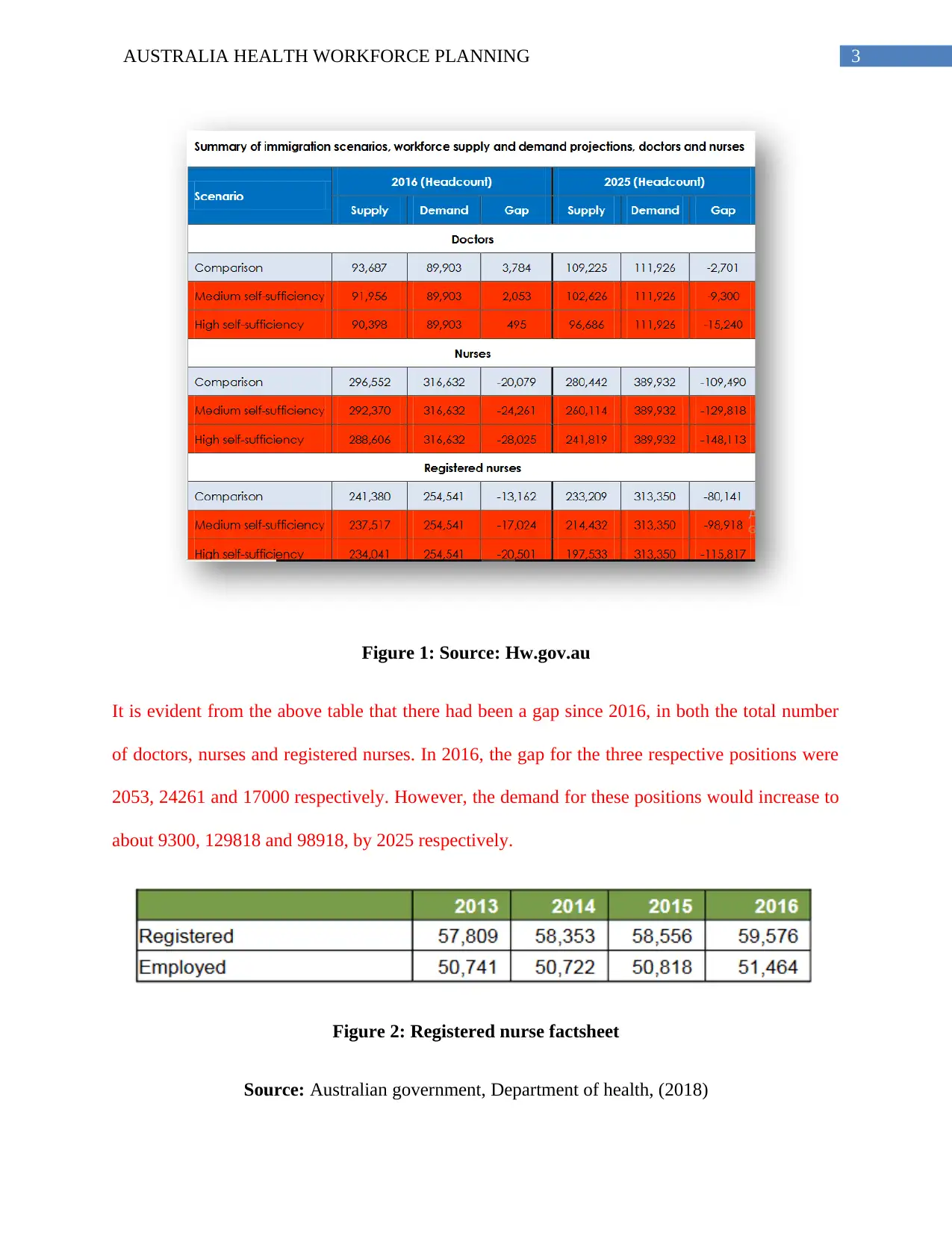
3AUSTRALIA HEALTH WORKFORCE PLANNING
Figure 1: Source: Hw.gov.au
It is evident from the above table that there had been a gap since 2016, in both the total number
of doctors, nurses and registered nurses. In 2016, the gap for the three respective positions were
2053, 24261 and 17000 respectively. However, the demand for these positions would increase to
about 9300, 129818 and 98918, by 2025 respectively.
Figure 2: Registered nurse factsheet
Source: Australian government, Department of health, (2018)
Figure 1: Source: Hw.gov.au
It is evident from the above table that there had been a gap since 2016, in both the total number
of doctors, nurses and registered nurses. In 2016, the gap for the three respective positions were
2053, 24261 and 17000 respectively. However, the demand for these positions would increase to
about 9300, 129818 and 98918, by 2025 respectively.
Figure 2: Registered nurse factsheet
Source: Australian government, Department of health, (2018)
Paraphrase This Document
Need a fresh take? Get an instant paraphrase of this document with our AI Paraphraser
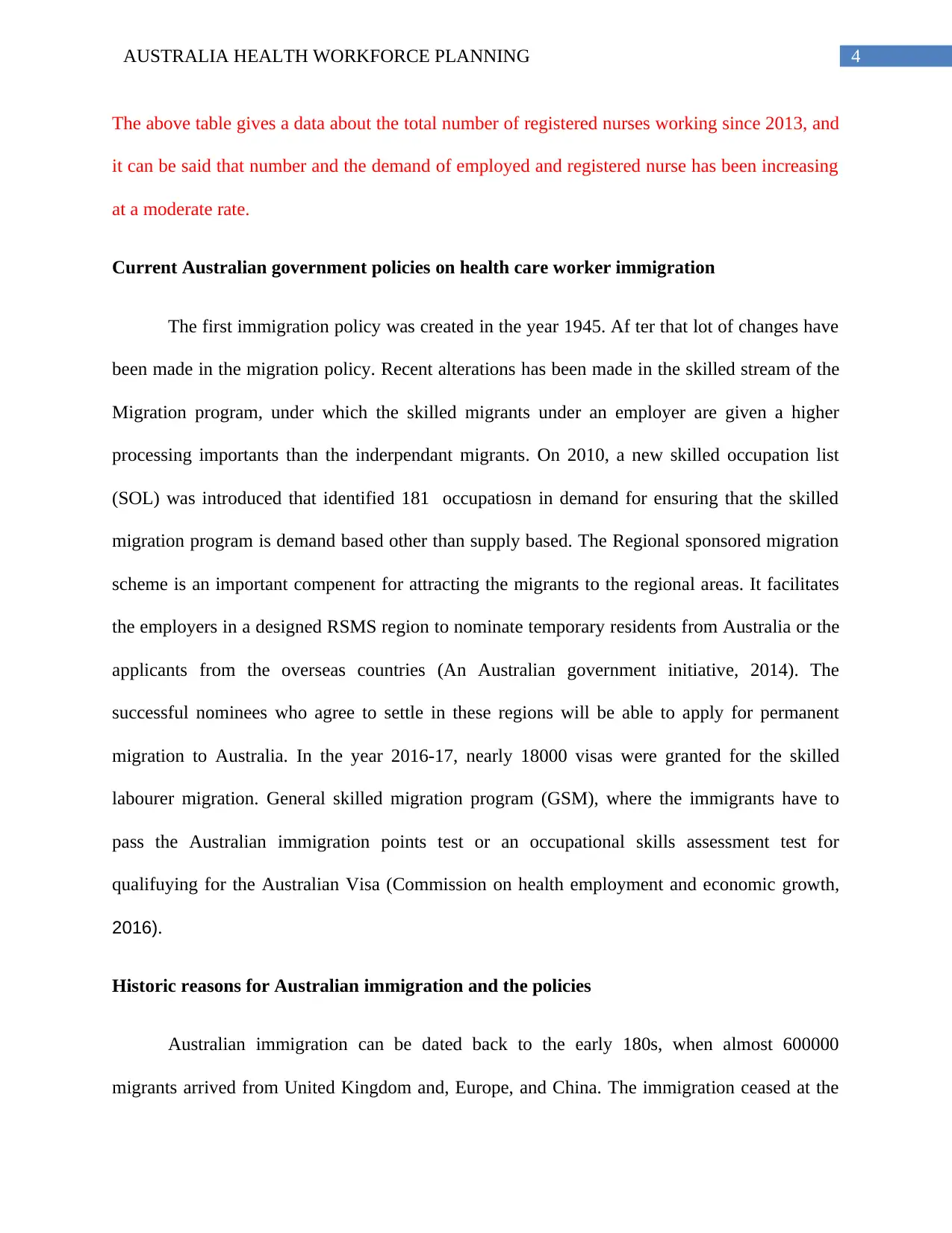
4AUSTRALIA HEALTH WORKFORCE PLANNING
The above table gives a data about the total number of registered nurses working since 2013, and
it can be said that number and the demand of employed and registered nurse has been increasing
at a moderate rate.
Current Australian government policies on health care worker immigration
The first immigration policy was created in the year 1945. Af ter that lot of changes have
been made in the migration policy. Recent alterations has been made in the skilled stream of the
Migration program, under which the skilled migrants under an employer are given a higher
processing importants than the inderpendant migrants. On 2010, a new skilled occupation list
(SOL) was introduced that identified 181 occupatiosn in demand for ensuring that the skilled
migration program is demand based other than supply based. The Regional sponsored migration
scheme is an important compenent for attracting the migrants to the regional areas. It facilitates
the employers in a designed RSMS region to nominate temporary residents from Australia or the
applicants from the overseas countries (An Australian government initiative, 2014). The
successful nominees who agree to settle in these regions will be able to apply for permanent
migration to Australia. In the year 2016-17, nearly 18000 visas were granted for the skilled
labourer migration. General skilled migration program (GSM), where the immigrants have to
pass the Australian immigration points test or an occupational skills assessment test for
qualifuying for the Australian Visa (Commission on health employment and economic growth,
2016).
Historic reasons for Australian immigration and the policies
Australian immigration can be dated back to the early 180s, when almost 600000
migrants arrived from United Kingdom and, Europe, and China. The immigration ceased at the
The above table gives a data about the total number of registered nurses working since 2013, and
it can be said that number and the demand of employed and registered nurse has been increasing
at a moderate rate.
Current Australian government policies on health care worker immigration
The first immigration policy was created in the year 1945. Af ter that lot of changes have
been made in the migration policy. Recent alterations has been made in the skilled stream of the
Migration program, under which the skilled migrants under an employer are given a higher
processing importants than the inderpendant migrants. On 2010, a new skilled occupation list
(SOL) was introduced that identified 181 occupatiosn in demand for ensuring that the skilled
migration program is demand based other than supply based. The Regional sponsored migration
scheme is an important compenent for attracting the migrants to the regional areas. It facilitates
the employers in a designed RSMS region to nominate temporary residents from Australia or the
applicants from the overseas countries (An Australian government initiative, 2014). The
successful nominees who agree to settle in these regions will be able to apply for permanent
migration to Australia. In the year 2016-17, nearly 18000 visas were granted for the skilled
labourer migration. General skilled migration program (GSM), where the immigrants have to
pass the Australian immigration points test or an occupational skills assessment test for
qualifuying for the Australian Visa (Commission on health employment and economic growth,
2016).
Historic reasons for Australian immigration and the policies
Australian immigration can be dated back to the early 180s, when almost 600000
migrants arrived from United Kingdom and, Europe, and China. The immigration ceased at the
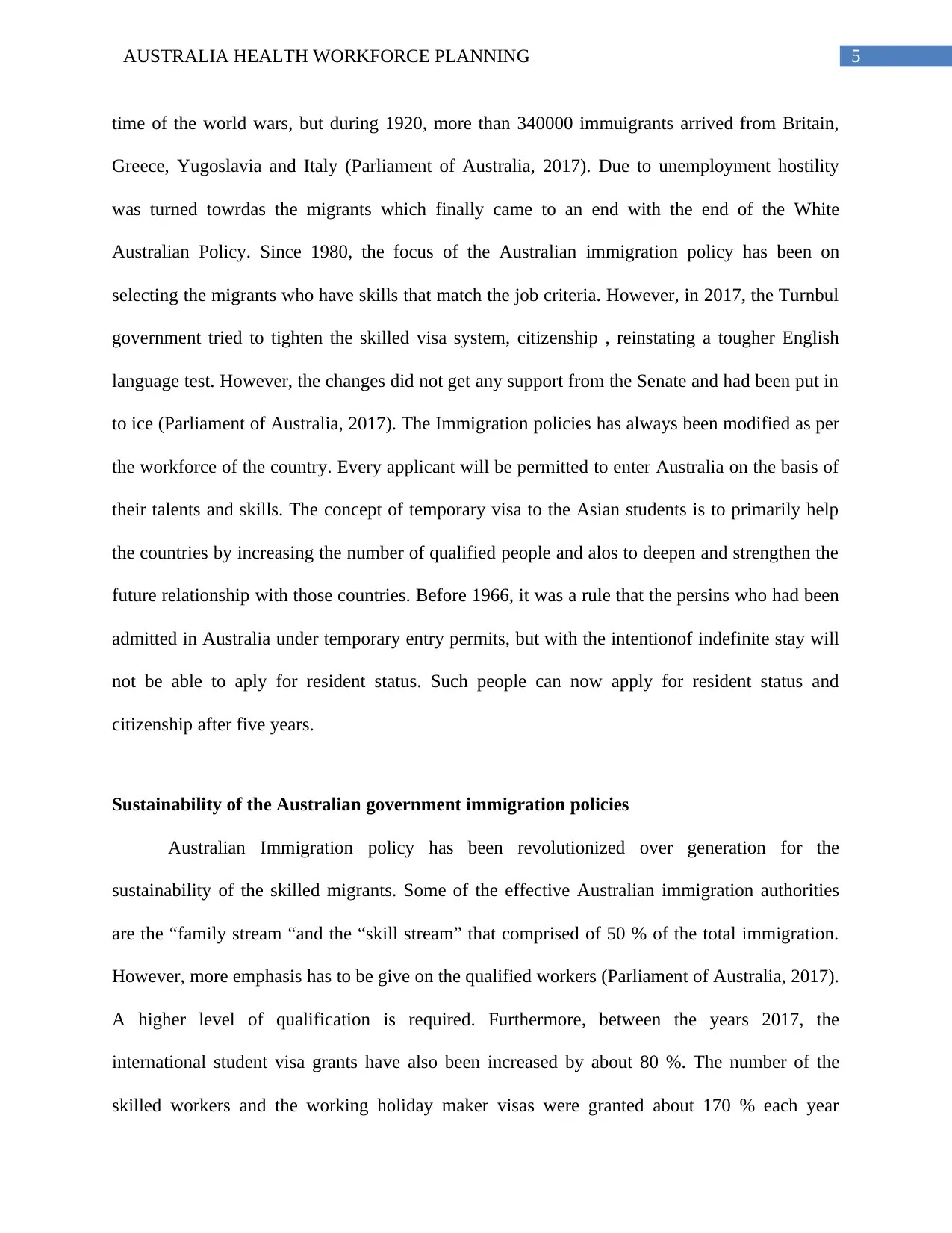
5AUSTRALIA HEALTH WORKFORCE PLANNING
time of the world wars, but during 1920, more than 340000 immuigrants arrived from Britain,
Greece, Yugoslavia and Italy (Parliament of Australia, 2017). Due to unemployment hostility
was turned towrdas the migrants which finally came to an end with the end of the White
Australian Policy. Since 1980, the focus of the Australian immigration policy has been on
selecting the migrants who have skills that match the job criteria. However, in 2017, the Turnbul
government tried to tighten the skilled visa system, citizenship , reinstating a tougher English
language test. However, the changes did not get any support from the Senate and had been put in
to ice (Parliament of Australia, 2017). The Immigration policies has always been modified as per
the workforce of the country. Every applicant will be permitted to enter Australia on the basis of
their talents and skills. The concept of temporary visa to the Asian students is to primarily help
the countries by increasing the number of qualified people and alos to deepen and strengthen the
future relationship with those countries. Before 1966, it was a rule that the persins who had been
admitted in Australia under temporary entry permits, but with the intentionof indefinite stay will
not be able to aply for resident status. Such people can now apply for resident status and
citizenship after five years.
Sustainability of the Australian government immigration policies
Australian Immigration policy has been revolutionized over generation for the
sustainability of the skilled migrants. Some of the effective Australian immigration authorities
are the “family stream “and the “skill stream” that comprised of 50 % of the total immigration.
However, more emphasis has to be give on the qualified workers (Parliament of Australia, 2017).
A higher level of qualification is required. Furthermore, between the years 2017, the
international student visa grants have also been increased by about 80 %. The number of the
skilled workers and the working holiday maker visas were granted about 170 % each year
time of the world wars, but during 1920, more than 340000 immuigrants arrived from Britain,
Greece, Yugoslavia and Italy (Parliament of Australia, 2017). Due to unemployment hostility
was turned towrdas the migrants which finally came to an end with the end of the White
Australian Policy. Since 1980, the focus of the Australian immigration policy has been on
selecting the migrants who have skills that match the job criteria. However, in 2017, the Turnbul
government tried to tighten the skilled visa system, citizenship , reinstating a tougher English
language test. However, the changes did not get any support from the Senate and had been put in
to ice (Parliament of Australia, 2017). The Immigration policies has always been modified as per
the workforce of the country. Every applicant will be permitted to enter Australia on the basis of
their talents and skills. The concept of temporary visa to the Asian students is to primarily help
the countries by increasing the number of qualified people and alos to deepen and strengthen the
future relationship with those countries. Before 1966, it was a rule that the persins who had been
admitted in Australia under temporary entry permits, but with the intentionof indefinite stay will
not be able to aply for resident status. Such people can now apply for resident status and
citizenship after five years.
Sustainability of the Australian government immigration policies
Australian Immigration policy has been revolutionized over generation for the
sustainability of the skilled migrants. Some of the effective Australian immigration authorities
are the “family stream “and the “skill stream” that comprised of 50 % of the total immigration.
However, more emphasis has to be give on the qualified workers (Parliament of Australia, 2017).
A higher level of qualification is required. Furthermore, between the years 2017, the
international student visa grants have also been increased by about 80 %. The number of the
skilled workers and the working holiday maker visas were granted about 170 % each year
⊘ This is a preview!⊘
Do you want full access?
Subscribe today to unlock all pages.

Trusted by 1+ million students worldwide
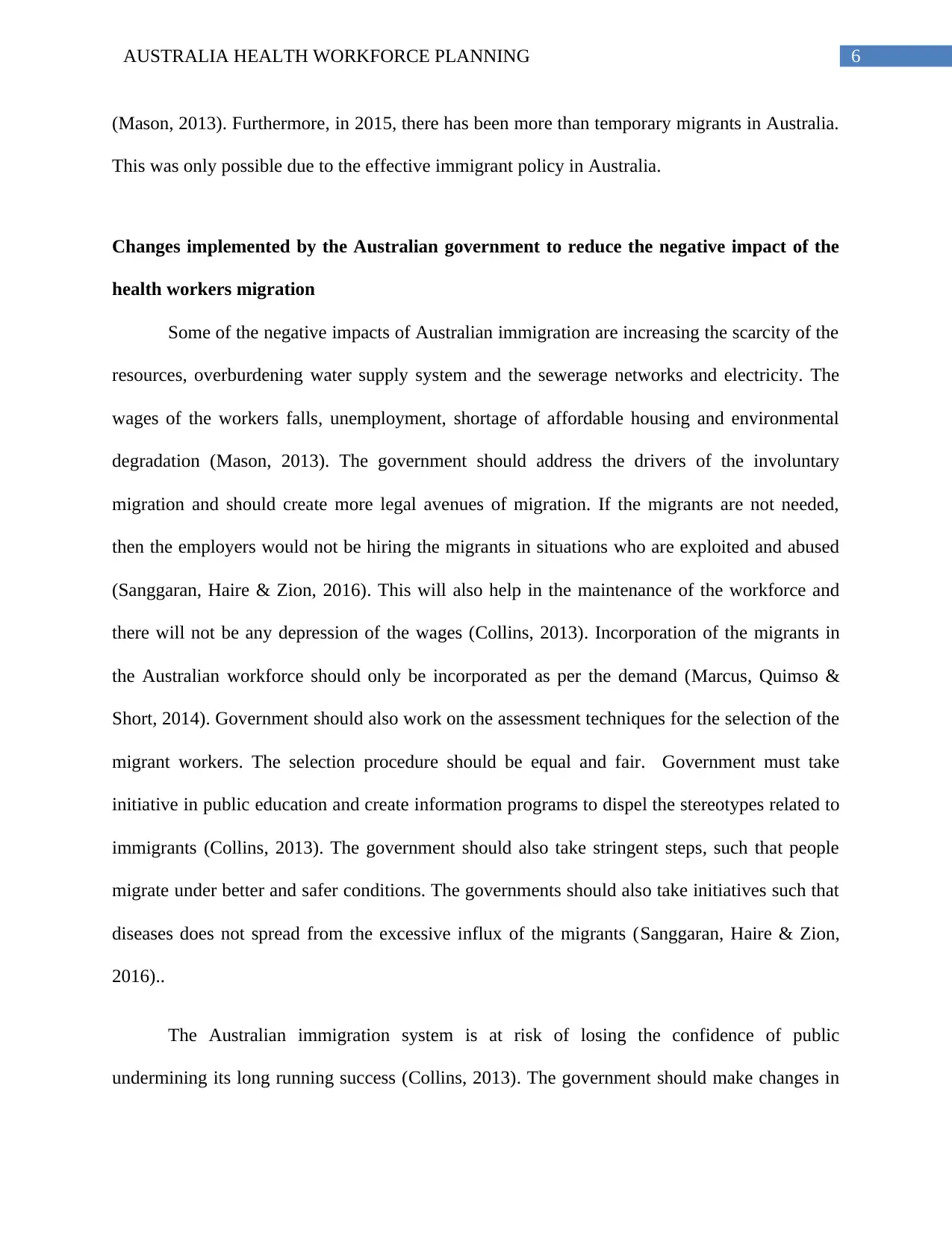
6AUSTRALIA HEALTH WORKFORCE PLANNING
(Mason, 2013). Furthermore, in 2015, there has been more than temporary migrants in Australia.
This was only possible due to the effective immigrant policy in Australia.
Changes implemented by the Australian government to reduce the negative impact of the
health workers migration
Some of the negative impacts of Australian immigration are increasing the scarcity of the
resources, overburdening water supply system and the sewerage networks and electricity. The
wages of the workers falls, unemployment, shortage of affordable housing and environmental
degradation (Mason, 2013). The government should address the drivers of the involuntary
migration and should create more legal avenues of migration. If the migrants are not needed,
then the employers would not be hiring the migrants in situations who are exploited and abused
(Sanggaran, Haire & Zion, 2016). This will also help in the maintenance of the workforce and
there will not be any depression of the wages (Collins, 2013). Incorporation of the migrants in
the Australian workforce should only be incorporated as per the demand (Marcus, Quimso &
Short, 2014). Government should also work on the assessment techniques for the selection of the
migrant workers. The selection procedure should be equal and fair. Government must take
initiative in public education and create information programs to dispel the stereotypes related to
immigrants (Collins, 2013). The government should also take stringent steps, such that people
migrate under better and safer conditions. The governments should also take initiatives such that
diseases does not spread from the excessive influx of the migrants (Sanggaran, Haire & Zion,
2016)..
The Australian immigration system is at risk of losing the confidence of public
undermining its long running success (Collins, 2013). The government should make changes in
(Mason, 2013). Furthermore, in 2015, there has been more than temporary migrants in Australia.
This was only possible due to the effective immigrant policy in Australia.
Changes implemented by the Australian government to reduce the negative impact of the
health workers migration
Some of the negative impacts of Australian immigration are increasing the scarcity of the
resources, overburdening water supply system and the sewerage networks and electricity. The
wages of the workers falls, unemployment, shortage of affordable housing and environmental
degradation (Mason, 2013). The government should address the drivers of the involuntary
migration and should create more legal avenues of migration. If the migrants are not needed,
then the employers would not be hiring the migrants in situations who are exploited and abused
(Sanggaran, Haire & Zion, 2016). This will also help in the maintenance of the workforce and
there will not be any depression of the wages (Collins, 2013). Incorporation of the migrants in
the Australian workforce should only be incorporated as per the demand (Marcus, Quimso &
Short, 2014). Government should also work on the assessment techniques for the selection of the
migrant workers. The selection procedure should be equal and fair. Government must take
initiative in public education and create information programs to dispel the stereotypes related to
immigrants (Collins, 2013). The government should also take stringent steps, such that people
migrate under better and safer conditions. The governments should also take initiatives such that
diseases does not spread from the excessive influx of the migrants (Sanggaran, Haire & Zion,
2016)..
The Australian immigration system is at risk of losing the confidence of public
undermining its long running success (Collins, 2013). The government should make changes in
Paraphrase This Document
Need a fresh take? Get an instant paraphrase of this document with our AI Paraphraser
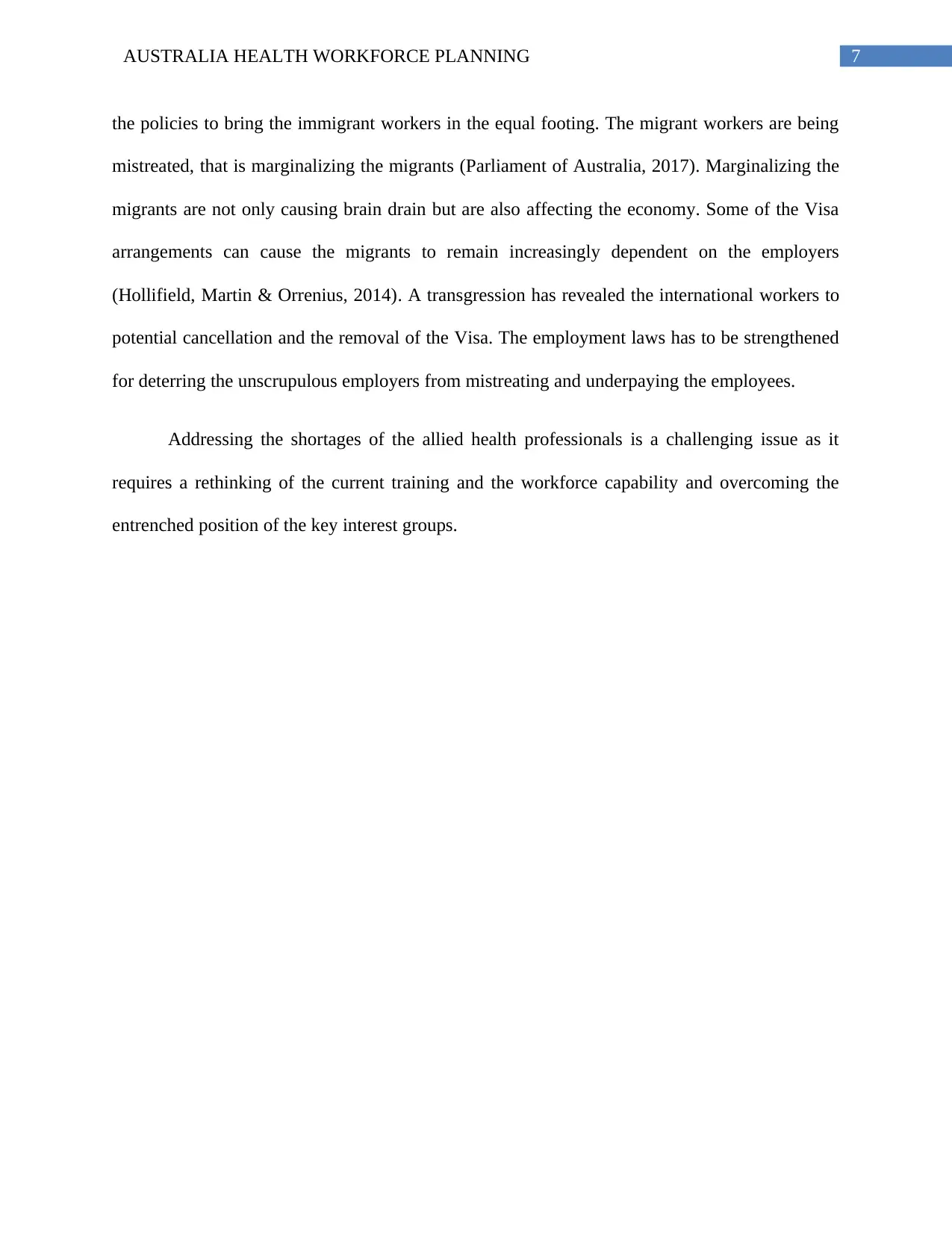
7AUSTRALIA HEALTH WORKFORCE PLANNING
the policies to bring the immigrant workers in the equal footing. The migrant workers are being
mistreated, that is marginalizing the migrants (Parliament of Australia, 2017). Marginalizing the
migrants are not only causing brain drain but are also affecting the economy. Some of the Visa
arrangements can cause the migrants to remain increasingly dependent on the employers
(Hollifield, Martin & Orrenius, 2014). A transgression has revealed the international workers to
potential cancellation and the removal of the Visa. The employment laws has to be strengthened
for deterring the unscrupulous employers from mistreating and underpaying the employees.
Addressing the shortages of the allied health professionals is a challenging issue as it
requires a rethinking of the current training and the workforce capability and overcoming the
entrenched position of the key interest groups.
the policies to bring the immigrant workers in the equal footing. The migrant workers are being
mistreated, that is marginalizing the migrants (Parliament of Australia, 2017). Marginalizing the
migrants are not only causing brain drain but are also affecting the economy. Some of the Visa
arrangements can cause the migrants to remain increasingly dependent on the employers
(Hollifield, Martin & Orrenius, 2014). A transgression has revealed the international workers to
potential cancellation and the removal of the Visa. The employment laws has to be strengthened
for deterring the unscrupulous employers from mistreating and underpaying the employees.
Addressing the shortages of the allied health professionals is a challenging issue as it
requires a rethinking of the current training and the workforce capability and overcoming the
entrenched position of the key interest groups.
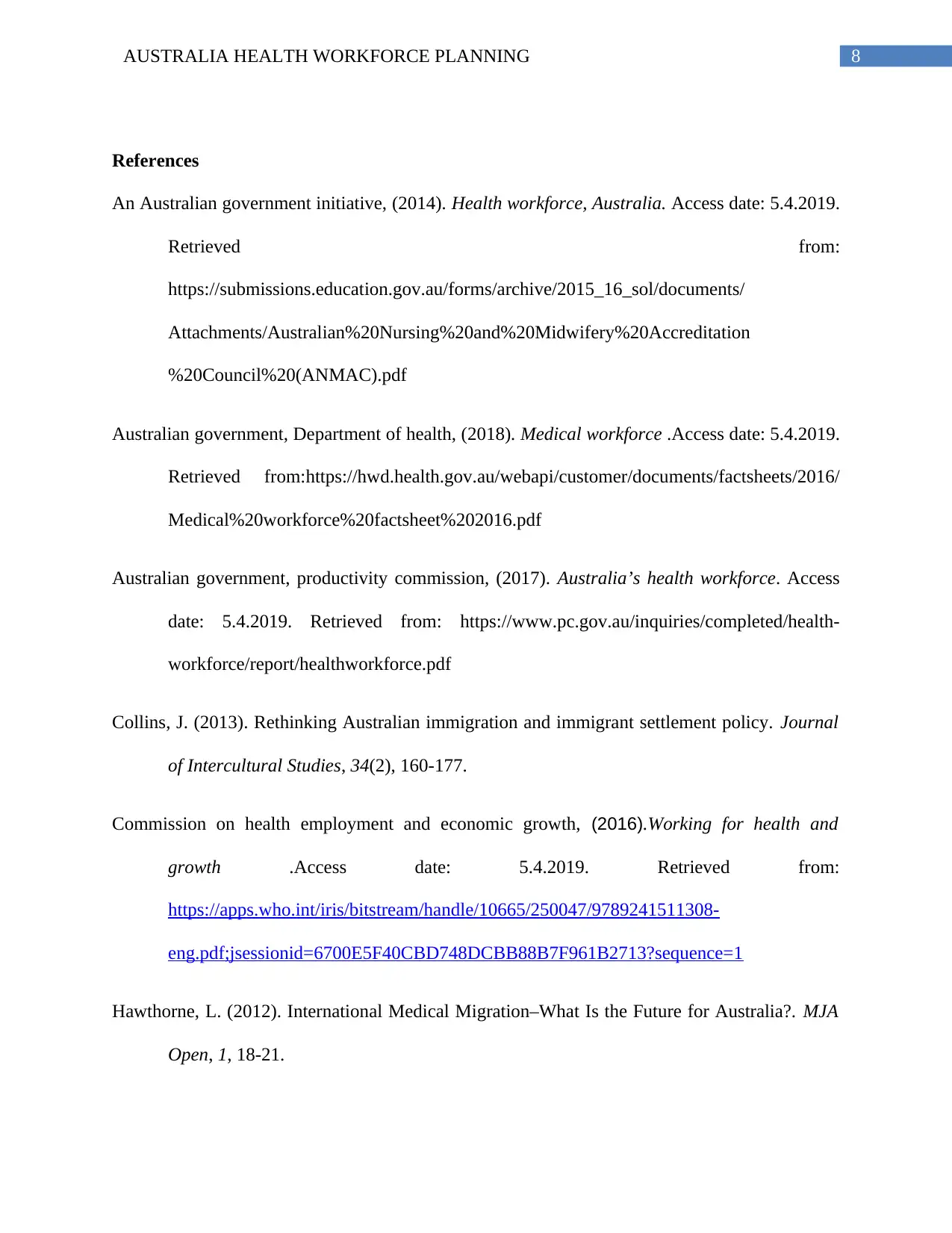
8AUSTRALIA HEALTH WORKFORCE PLANNING
References
An Australian government initiative, (2014). Health workforce, Australia. Access date: 5.4.2019.
Retrieved from:
https://submissions.education.gov.au/forms/archive/2015_16_sol/documents/
Attachments/Australian%20Nursing%20and%20Midwifery%20Accreditation
%20Council%20(ANMAC).pdf
Australian government, Department of health, (2018). Medical workforce .Access date: 5.4.2019.
Retrieved from:https://hwd.health.gov.au/webapi/customer/documents/factsheets/2016/
Medical%20workforce%20factsheet%202016.pdf
Australian government, productivity commission, (2017). Australia’s health workforce. Access
date: 5.4.2019. Retrieved from: https://www.pc.gov.au/inquiries/completed/health-
workforce/report/healthworkforce.pdf
Collins, J. (2013). Rethinking Australian immigration and immigrant settlement policy. Journal
of Intercultural Studies, 34(2), 160-177.
Commission on health employment and economic growth, (2016).Working for health and
growth .Access date: 5.4.2019. Retrieved from:
https://apps.who.int/iris/bitstream/handle/10665/250047/9789241511308-
eng.pdf;jsessionid=6700E5F40CBD748DCBB88B7F961B2713?sequence=1
Hawthorne, L. (2012). International Medical Migration–What Is the Future for Australia?. MJA
Open, 1, 18-21.
References
An Australian government initiative, (2014). Health workforce, Australia. Access date: 5.4.2019.
Retrieved from:
https://submissions.education.gov.au/forms/archive/2015_16_sol/documents/
Attachments/Australian%20Nursing%20and%20Midwifery%20Accreditation
%20Council%20(ANMAC).pdf
Australian government, Department of health, (2018). Medical workforce .Access date: 5.4.2019.
Retrieved from:https://hwd.health.gov.au/webapi/customer/documents/factsheets/2016/
Medical%20workforce%20factsheet%202016.pdf
Australian government, productivity commission, (2017). Australia’s health workforce. Access
date: 5.4.2019. Retrieved from: https://www.pc.gov.au/inquiries/completed/health-
workforce/report/healthworkforce.pdf
Collins, J. (2013). Rethinking Australian immigration and immigrant settlement policy. Journal
of Intercultural Studies, 34(2), 160-177.
Commission on health employment and economic growth, (2016).Working for health and
growth .Access date: 5.4.2019. Retrieved from:
https://apps.who.int/iris/bitstream/handle/10665/250047/9789241511308-
eng.pdf;jsessionid=6700E5F40CBD748DCBB88B7F961B2713?sequence=1
Hawthorne, L. (2012). International Medical Migration–What Is the Future for Australia?. MJA
Open, 1, 18-21.
⊘ This is a preview!⊘
Do you want full access?
Subscribe today to unlock all pages.

Trusted by 1+ million students worldwide
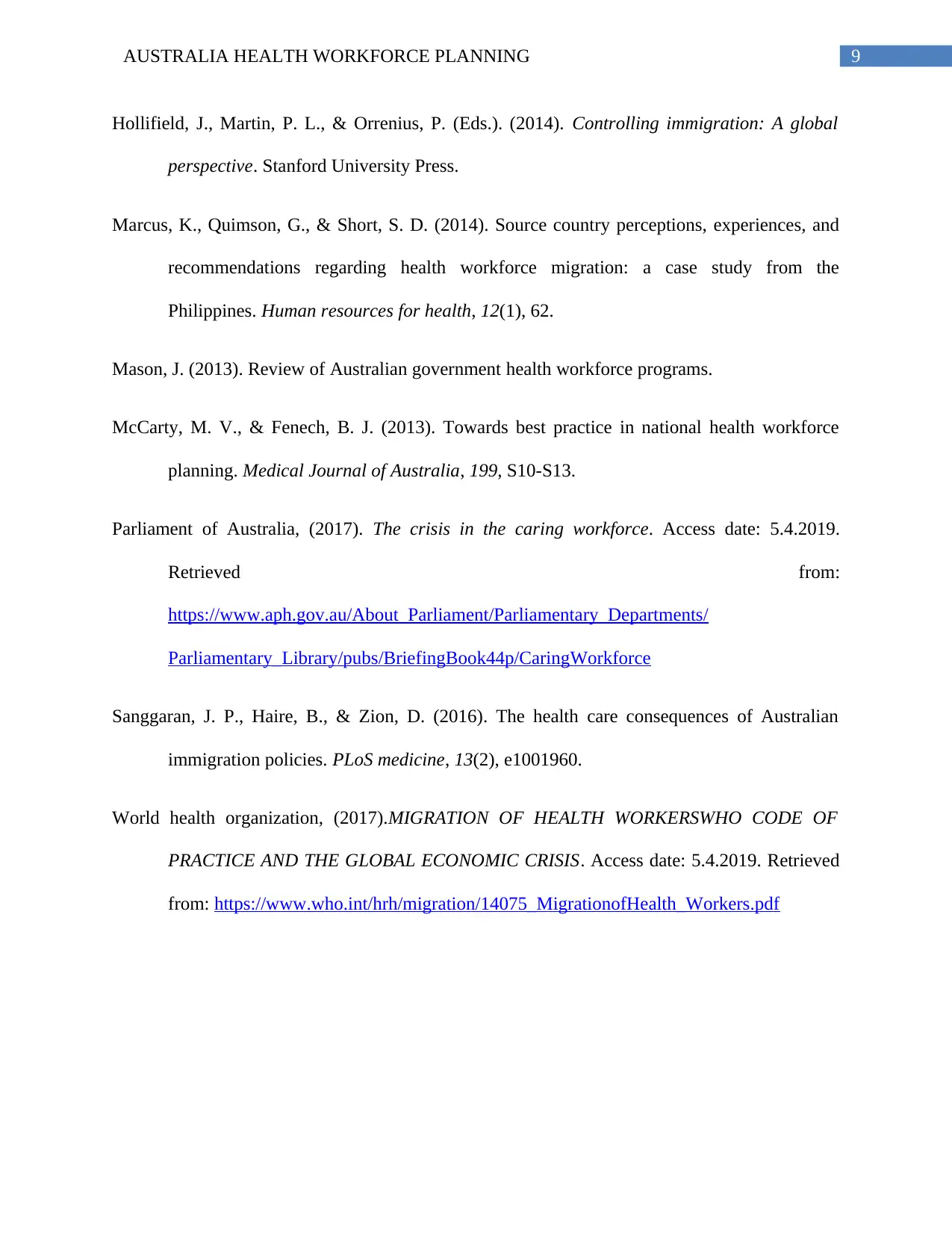
9AUSTRALIA HEALTH WORKFORCE PLANNING
Hollifield, J., Martin, P. L., & Orrenius, P. (Eds.). (2014). Controlling immigration: A global
perspective. Stanford University Press.
Marcus, K., Quimson, G., & Short, S. D. (2014). Source country perceptions, experiences, and
recommendations regarding health workforce migration: a case study from the
Philippines. Human resources for health, 12(1), 62.
Mason, J. (2013). Review of Australian government health workforce programs.
McCarty, M. V., & Fenech, B. J. (2013). Towards best practice in national health workforce
planning. Medical Journal of Australia, 199, S10-S13.
Parliament of Australia, (2017). The crisis in the caring workforce. Access date: 5.4.2019.
Retrieved from:
https://www.aph.gov.au/About_Parliament/Parliamentary_Departments/
Parliamentary_Library/pubs/BriefingBook44p/CaringWorkforce
Sanggaran, J. P., Haire, B., & Zion, D. (2016). The health care consequences of Australian
immigration policies. PLoS medicine, 13(2), e1001960.
World health organization, (2017).MIGRATION OF HEALTH WORKERSWHO CODE OF
PRACTICE AND THE GLOBAL ECONOMIC CRISIS. Access date: 5.4.2019. Retrieved
from: https://www.who.int/hrh/migration/14075_MigrationofHealth_Workers.pdf
Hollifield, J., Martin, P. L., & Orrenius, P. (Eds.). (2014). Controlling immigration: A global
perspective. Stanford University Press.
Marcus, K., Quimson, G., & Short, S. D. (2014). Source country perceptions, experiences, and
recommendations regarding health workforce migration: a case study from the
Philippines. Human resources for health, 12(1), 62.
Mason, J. (2013). Review of Australian government health workforce programs.
McCarty, M. V., & Fenech, B. J. (2013). Towards best practice in national health workforce
planning. Medical Journal of Australia, 199, S10-S13.
Parliament of Australia, (2017). The crisis in the caring workforce. Access date: 5.4.2019.
Retrieved from:
https://www.aph.gov.au/About_Parliament/Parliamentary_Departments/
Parliamentary_Library/pubs/BriefingBook44p/CaringWorkforce
Sanggaran, J. P., Haire, B., & Zion, D. (2016). The health care consequences of Australian
immigration policies. PLoS medicine, 13(2), e1001960.
World health organization, (2017).MIGRATION OF HEALTH WORKERSWHO CODE OF
PRACTICE AND THE GLOBAL ECONOMIC CRISIS. Access date: 5.4.2019. Retrieved
from: https://www.who.int/hrh/migration/14075_MigrationofHealth_Workers.pdf
1 out of 10
Related Documents
Your All-in-One AI-Powered Toolkit for Academic Success.
+13062052269
info@desklib.com
Available 24*7 on WhatsApp / Email
![[object Object]](/_next/static/media/star-bottom.7253800d.svg)
Unlock your academic potential
Copyright © 2020–2025 A2Z Services. All Rights Reserved. Developed and managed by ZUCOL.





